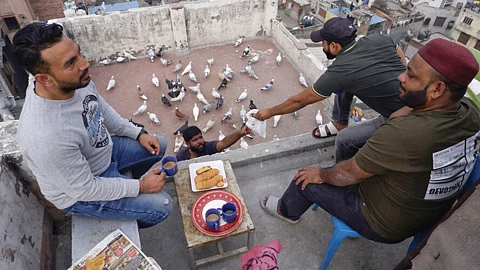
- HOMEGROWN WORLD
- #HGCREATORS
- #HGEXPLORE
- #HGVOICES
- #HGSHOP
- CAREERS
- ABOUT US
- CONTACT US

Whether it’s the music video of 'Masakali' or the terraces in the bylanes of Old Delhi, pigeons are a part of Delhi’s ecosystem, where kabootarbazi, or pigeon rearing has become an essential part of people's lives.
In the 17th Century, these pigeons were used for communication by Muslim rulers and nobles. Mughal Emperor Babur’s Tuzk-e-Babri refers to the kabootarbazi as a favourite. Old Delhi’s pigeon keeping community might just seem like a bunch of old men setting their pigeons free for flight and expecting them back anxiously, in a game that usually lasts 30 minutes. However, a great deal of effort goes into preparing for the tournaments. Kabootarbazi is all about training pigeons to fly from their 'kaabuks' or coops and return to them. The pigeons follow their master's signals and compete with the opponent's flock. The task? Fly back home with all your birds, and a few of the opponent's birds, while trying to seperate an oppsing flock. When a pigeon from one group goes with another, the owner not only loses the pigeon but also has to pay back an amount worthy of boththe breed and skills of the pigeon to get it back. Owners often go to great lengths to keep their pigeons.
Kabootarbazi competitions are a common winter sky sight in Old Delhi and Agra. Between November and February, pigeons flock away everyday in the afternoon to distant locations, and return home with a new bird. Ustads are sometimes known to bathe their pigeons in ittar or perfume to make the birds of a flock more recognisable through their scent.
From whistling to shouting syllables, all ustads and shahgirds have created languages of their own for the birds. It’s interesting that the kabootarbaz community also have a separate vocabulary of their own — larana or tracking the opponent’s birds, and hakana, which means to race are a few examples. Like any highly coordinated sport, the pigeon keepers work in a strict hierarchy. A shahgird is a trainee below the khaleefa, the senior, and the ustads, are the experts. An ustad usually has many khaleefas under him who have trained or learnt the sport from him. One can challenge an ustad to a kushti or a competition, only when they have challenged and defeated the ustad’s khaleefa. According to an article by the Hindustan Times, there are about 30 ustads in Old Delhi, and only one of them is a woman.
A khabootarbaz’s morning begins with feeding the birds. The pigeons are fed ghee, chapatis, raisins, almonds, malai, and khoya to keep them warm and strong in the winters. They are then trained through timed flights, and callbacks like whistles, claps, sounds and syllables. Evenings are for practice competitions. The kabootars certainly have a tight schedule.
The community has over time developed strong bonds, not only with the pigeons but also with each other. Each bird is trained to recognise their ustad’s voice and trust their call. It’s a relationship that can’t be built overnight. Becoming a kabootarbaz is not something that happens overnight — it's a journey of dedication and quiet mastery.
If you enjoyed reading this, here's more from Homegrown:
Get Over Harry Potter: India's First Pigeon Postal Service Is In Odisha
A Glimpse Of 19th Century Delhi Through Mirza Ghalib’s Old Haveli
Watch A Homegrown Film That Captures The Lives Of Old Delhi's Underprivileged
